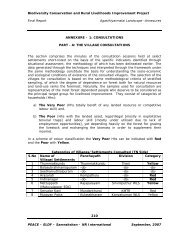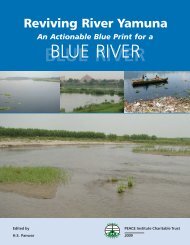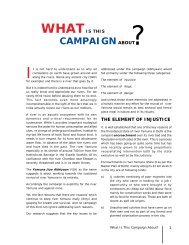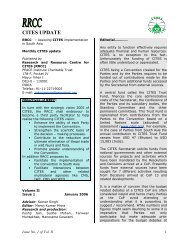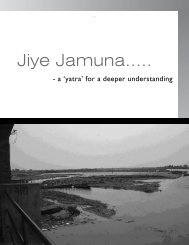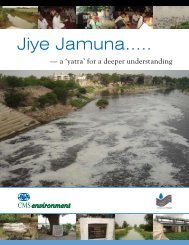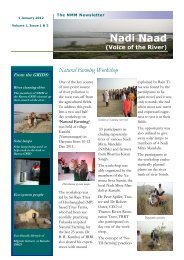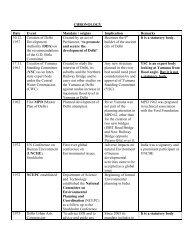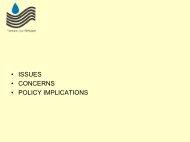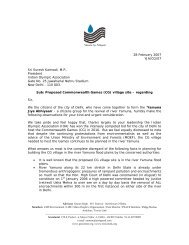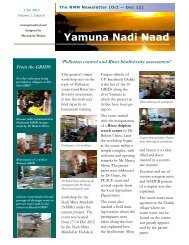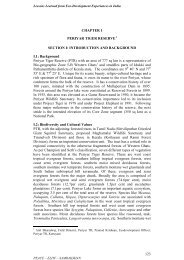NMM Newsletter April 2012.pdf - PEACE Institute Charitable Trust
NMM Newsletter April 2012.pdf - PEACE Institute Charitable Trust
NMM Newsletter April 2012.pdf - PEACE Institute Charitable Trust
You also want an ePaper? Increase the reach of your titles
YUMPU automatically turns print PDFs into web optimized ePapers that Google loves.
1 <strong>April</strong> 2012<br />
The <strong>NMM</strong> <strong>Newsletter</strong><br />
Vol. 1 Issue 3<br />
Conceptualized and<br />
designed by<br />
Meenakshi Mohan<br />
Nadi Naad<br />
(Call of the River Yamuna)<br />
From the GRIDS:<br />
Drive to keep river banks<br />
clean<br />
<strong>NMM</strong>s at Ramra, Pachnada and<br />
Hamirpur GRIDs took active part<br />
in keeping the river banks clean<br />
Outreach to other stakeholders<br />
<strong>NMM</strong>s at Kharadi, Katapathar,<br />
Kanalsi, Ramra, Hamirpur made<br />
useful outreach to relevant stakeholders<br />
like Panchayat and other<br />
govt deptts<br />
Planning & Execution of<br />
activities<br />
<strong>NMM</strong> members at Katapathar<br />
GRID planning in the field and at<br />
Gadaya GRID erecting fence<br />
Water and Soil testing techniques Workshop<br />
A two day training workshop<br />
on “Water and Soil testing<br />
techniques” for the members<br />
of the <strong>NMM</strong>s from all the 10<br />
GRIDS was held from 16-18<br />
March 2012. This workshop<br />
was ably hosted by the <strong>NMM</strong><br />
at Hamirpur (UP) GRID. It is<br />
notable that the river Yamuna<br />
is here, in its revived phase,<br />
resulting from fresh water<br />
brought to it by key tributaries<br />
like Chambal and Sindh. River<br />
Betwa meets Yamuna at this<br />
GRID.<br />
Day before the workshop, the<br />
participants visited and enjoyed<br />
boating in the river, the<br />
first time such an opportunity<br />
had come their way.<br />
Day one of the workshop<br />
was meant for water testing<br />
techniques. Bhim, Dr Taigor<br />
and Dr Dinesh Kumar led the<br />
workshop.<br />
Participants were first introduced<br />
to the origins and rarity<br />
of fresh water on earth and<br />
how the purity of fresh water<br />
is assessed.<br />
A water testing kit, one for each<br />
GRID, with requisite equipment<br />
and reagents was supplied and<br />
Dr Dinesh guided, hands on, the<br />
participants through use of the<br />
same.<br />
For the participants it was a<br />
unique learning experience,<br />
which many relished while few<br />
struggled. But finally all learnt<br />
how to test water for parameters<br />
like temperature, pH, hardness,<br />
turbidity, nitrate, fluoride, chloride<br />
and iron content. It is notable<br />
that the water samples from<br />
the hilly GRIDS tested within<br />
safe limits. Ground water from<br />
hand pump at Merapur village<br />
was tested and found to exceed<br />
safe range both for iron and<br />
nitrate.<br />
Due precautions to be observed<br />
while using the test kit was also<br />
explained to the participants.<br />
Sri Khan, expert on soil testing<br />
addressing the participants<br />
On day two the participants<br />
visited Merapur village and<br />
planted seedlings of local<br />
species along side the local<br />
pond being restored by the<br />
<strong>NMM</strong>. A visit was also<br />
made to the river bank site<br />
where successful plantation<br />
from the current year exist.<br />
Later Dr MA Khan, the<br />
local scientist in charge of<br />
the district Soil testing laboratory,<br />
led the workshop on<br />
Soil testing techniques.<br />
After a detailed lecture on<br />
how and why of soil health<br />
he explained with charts and<br />
pamphlets the method for<br />
collection of soil sample<br />
from a site. Later he elaborated<br />
on why the common<br />
practice of use of salt to<br />
improve soil quality was<br />
faulty and instead why and<br />
how should potash be used.<br />
The workshop ended with<br />
each participant sharing his<br />
respective experiences and<br />
learnings gained. Dr Dhyani<br />
from the Katapathar GRID<br />
shared his version in form<br />
of a memorable poem titled,<br />
“Ye tera nahi Mera Hai”.
P a ge 2 N a di Naad V o l. 1 I s s u e 3<br />
ECO-CLUB News:<br />
Katapathar GRID<br />
Mr Rawat, local district forest<br />
officer (DFO) addressing the<br />
members of Yamuna Ecoscholar<br />
(YES) group<br />
Ramra GRID<br />
YES members with self created<br />
paper bags<br />
Field visit to the TITUS FARM<br />
Mr Raju Titus, of Titus<br />
Farms, Hoshangabad<br />
(MP) invited interested<br />
farmers to visit his ‘Notill’<br />
natural farm to see<br />
for themselves the technique<br />
and usefulness of<br />
the natural farming<br />
practices. Accordingly<br />
22 persons, including 3<br />
resource persons visited<br />
the Titus Farm on<br />
21,22 February 2012.<br />
Mr Titus explains techniques<br />
to the participants<br />
the participants thus had<br />
a number of questions<br />
regarding it that Mr Titus<br />
endeavoured to respond<br />
over two days.<br />
ready adoption of<br />
the practices of<br />
natural farming.<br />
Another feature of<br />
natural farming is<br />
the use of mud seed<br />
balls, which was also<br />
shown to the participants.<br />
Formation of seed balls<br />
shown to the participants<br />
Pachanada GRID<br />
Five rivers at Pachnada<br />
drawn by YES members<br />
Hamirpur GRID<br />
(Prize distribution to winner)<br />
Naturally grown wheat at<br />
Titus Farm<br />
There were a number of<br />
question- answer sessions<br />
held by Mr Titus for the<br />
benefit of the participants.<br />
The technique of natural<br />
farming although traditional<br />
in the country has<br />
been lost over time and<br />
One of the key ingredient<br />
of natural farming<br />
is the utilization<br />
of every bit of organic<br />
material within<br />
the farm. Another is<br />
the key role played<br />
by tree crops in<br />
maintaining diversity,<br />
requisite shade for<br />
moisture conservation<br />
and as cash crop<br />
for the farmer. The<br />
reason why Mr Titus<br />
finds the conditions<br />
at the Kanalsi GRID<br />
where farming of<br />
Popular trees is in<br />
vogue to be ideal for<br />
Hoshangabad is located<br />
on the banks<br />
of river Narmada,<br />
which is one of the<br />
major and holy rivers<br />
of India. The participants<br />
thus took time<br />
out to visit the river<br />
Narmada and compare<br />
and contrast it<br />
with river Yamuna.<br />
Participants on the banks<br />
of river Narmada
N a di Naad V o l. 1 I s s u e 3<br />
P a ge 3<br />
Examples of good practices<br />
Fine example of water conservation through<br />
double soak pits to capture and soak the water<br />
left unutilized at a hand pump, at the Hamirpur<br />
GRID.<br />
PROJECT COM-<br />
PONENTS<br />
1.Institutional<br />
strengthening of<br />
<strong>NMM</strong>s<br />
2.Catchment restoration<br />
‘No till’ Natural farming of wheat on the<br />
banks of river Betwa at Hamirpur GRID<br />
3.River health & Village<br />
health Monitoring<br />
Central drain in village pathway in<br />
Ekdala GRID eliminates scope of<br />
any standing waste water.<br />
River bank being kept litter free on the occasion<br />
of religious festival at Ramra GRID.<br />
Solar powered drier for bakery products<br />
at Asan Tirth (HESCO), of Dr Anil Joshi, Shuklapur village Dehradun.<br />
4.Promotion of<br />
natural farming;<br />
waste management;<br />
green yatra; improved<br />
sanitation;<br />
ground water recharge;<br />
renewable<br />
energy (solar)<br />
5.Capacity enhancement<br />
workshops<br />
6.Eco-clubs (soil,<br />
water, river and air)<br />
7.Synergy with<br />
WWF India activities<br />
River dolphin sighted after considerable period on the confluence of river Yamuna<br />
and Betwa at Hamirpur GRID
<strong>PEACE</strong> <strong>Institute</strong> <strong>Charitable</strong> <strong>Trust</strong><br />
(PICT) in association with<br />
Thames Rivers Restoration <strong>Trust</strong><br />
(TRRT)<br />
<strong>PEACE</strong> <strong>Institute</strong> <strong>Charitable</strong> <strong>Trust</strong><br />
178-F, Pocket-4,<br />
Mayur Vihar Phase-1<br />
New Delhi-110091<br />
Tele-Fax: 91-11-22719005<br />
Email: manojmisra@peaceinst.org<br />
We are on the WEB!<br />
www.peaceinst.org<br />
Jiye Jamuna... Jiye Jan-Jan<br />
Editorial<br />
The last quarter (Jan-March) had been busy. Despite it being a severe winter, activities<br />
at most GRIDs picked up good momentum. Due largely to good efforts made in the<br />
field both by Bhim and Dr Taigor, the two field executives, the Nadi Mitra Mandalis<br />
(<strong>NMM</strong>) at all the 10 GRIDs performed their assigned tasks creditably. Most notable<br />
were the activities indulged in by the Eco-club (since renamed as YES - Yamuna Eco-<br />
Scholar) members.<br />
As noted elsewhere in this issue, special efforts were made early in the quarter by the<br />
<strong>NMM</strong> members at RAMRA, PACHNADA, and HAMIRPUR GRIDs to ensure that the<br />
river banks were kept free of waste generated during the annual bathing (nahan) festivals<br />
held during the month of January and February.<br />
As a follow up to training workshop held on Natural Farming, it was encouraging to<br />
find farmers at many GRIDs beginning to experiment with NO TILL and NO PESTI-<br />
CIDE use in their farms. A brief follow up trip on 20 February 2012 by farmers from 8<br />
GRIDs to TITUS FARMs (Hoshangabad) to see first hand for themselves what Sri<br />
Titus had been practicing was found useful. This we hope will help reduce river pollution<br />
from farm based, non-point sources.<br />
A two day workshop on “Water and Soil testing techniques” was held successfully at<br />
HAMIRPUR GRID from 16-18 March 2012 . Following the previous two workshops<br />
held in the upper Yamuna GRIDS of RAMRA and KANALSI, this was the fist one held<br />
in the lower Yamuna GRID.<br />
We hope that you have found this issue to be informative and interesting.<br />
Manoj Misra , Editor<br />
The Project Miscellanea<br />
Cormorants enjoying themselves in rejuvenated river Yamuna<br />
at Pachnada GRID. (January 2012)<br />
ued learning from others and<br />
meeting the many stewards of<br />
the river.”<br />
River Yamuna comes<br />
alive once river<br />
Chambal meets it<br />
upstream of Pachnada<br />
GRID .<br />
This January is indeed cool !<br />
<strong>PEACE</strong> <strong>Institute</strong><br />
hosts an Intern<br />
Ms Linda Ciesielski, a<br />
recent graduate of<br />
MIT’s Master of city<br />
planning program,<br />
worked as an intern at<br />
<strong>PEACE</strong> for 9 weeks<br />
beginning 6 February<br />
2012. She learnt about<br />
the Thames-Ganges<br />
Twinning project from<br />
the internet and volunteered<br />
to assist the<br />
project activities. In<br />
her own words:<br />
“ I interned with <strong>PEACE</strong><br />
this spring, and had a remarkable<br />
time learning about<br />
the Yamuna and complex<br />
issues surrounding its condition.<br />
I joined two “Friends of<br />
the River” workshops on notill<br />
agriculture and water/soil<br />
testing. Overall, I greatly val-<br />
Linda on the river Yamuna<br />
cruise at Hamirpur GRID<br />
Yamuna winding its way<br />
down, from its origins at the<br />
Kalind range of mountains<br />
(in the background)<br />
Munna lal at his organic<br />
farm in Pachnada GRID



